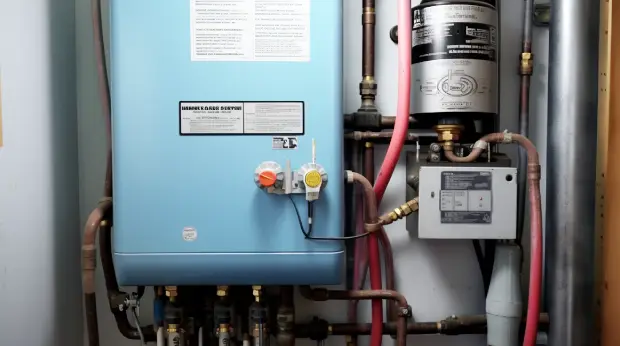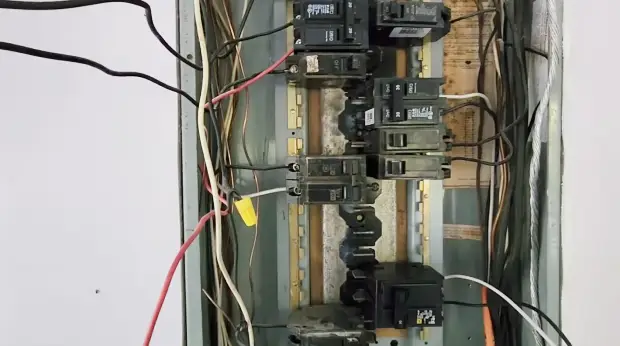Last Updated on October 3, 2023
Are you ready to dive deep into the world of well pump circuit breakers? If so, get ready to discover the secrets behind calculating the perfect size for your well pump’s circuit breaker.
Calculate the appropriate breaker size based on the pump’s current draw and the National Electrical Code guidelines. For a 1 HP, 230V single-phase submersible well pump, it’s recommended to use a 25 amp 2-pole circuit breaker according to electrical codes.
Understanding why the right size matters and the consequences of using a breaker that’s too small will empower you to make informed decisions. So, grab your tools and let’s explore the fascinating realm of well pump circuit breakers together.
How Do You Calculate the Size of a Circuit Breaker for a Well Pump?

When determining the size of a circuit breaker for a well pump, there are several key steps to follow.
- Step 01: Gather pump information
- Step 02: Calculate breaker size
- Step 03: Choose the nearest standard breaker size
- Step 04: Consider voltage drop
- Step 05: Consult local codes and the electrician
Let’s break down each of these steps in greater detail.
Step 01: Gather Pump Information
First, determine the pump’s horsepower (HP) rating. This information is crucial in calculating the circuit breaker size for your well pump. Here are some steps to guide you:
- Identify the pump’s operating voltage (usually 120V, 230V, or 240V). This will help you select the appropriate circuit breaker.
- Find the pump’s full-load current (FLC) in amps. The FLC can usually be found in the manufacturer’s manual. This value represents the maximum current the pump will draw during normal operation.
Step 02: Calculate Breaker Size
To calculate the appropriate breaker size for your well pump, you’ll need to multiply the pump’s full-load current by 2.5. This accounts for inrush or starting currents that the pump may experience.
The National Electric Code (NEC) provides guidelines for circuit breaker sizing based on the pump’s horsepower. The general formula for sizing the breaker is Breaker Size = FLC x 250%.
FLC stands for full-load current, which is the current that the pump draws when operating at its maximum capacity.
By multiplying the FLC by 2.5 or 250%, you ensure that the breaker can handle the starting current of the pump. This is important because the starting current can be significantly higher than the full-load current.
Step 03: Choose the Nearest Standard Breaker Size
Now, you can select the nearest standard breaker available in your electrical panel for your well pump. Here are the standard breaker sizes to choose from:
- Round up to the nearest standard breaker size: Common standard breaker sizes include 15A, 20A, 30A, 40A, etc. Round up the calculated breaker size to the nearest standard size available in your electrical panel. This ensures compatibility and proper functioning of the well pump.
- Consider the electrical panel’s capacity: Make sure that the chosen standard breaker size does not exceed your electrical panel’s capacity. It is important to maintain a safe and efficient electrical system.
Step 04: Consider Voltage Drop
When choosing the appropriate wire size for your well pump, don’t forget to consider voltage drop.
Voltage drop occurs when the distance between the well pump and the electrical panel is significant. You should take into account this voltage drop because if it is substantial, you may need to choose a larger wire size to compensate.
This compensatory measure will ensure that your well pump receives the necessary amount of voltage to function properly. Additionally, the wire size can also influence your breaker size choice.
Step 05: Consult Local Codes and Electrician
After considering voltage drops, consult local codes and an electrician to ensure that you are making the best choice for your system. You should consult an electrician and local codes to ensure compliance with regulations and receive expert advice.
When determining the size of the circuit breaker for a well pump, here are three key reasons why consulting an electrician and local codes is crucial:
- Safety: An electrician can evaluate the specific needs of your well pump system and recommend a circuit breaker that can handle the load safely, preventing electrical hazards and potential damage.
- Code Compliance: Local electrical codes may have specific requirements for well pump circuit breaker sizing. By consulting local codes, you can ensure that your installation meets the necessary standards and avoids any code violations.
- Efficiency: An electrician can help optimize the efficiency of your well pump system by selecting the right size circuit breaker. This can help minimize energy wastage and reduce operational costs in the long run.
Why Do Well Pumps Need the Right Size Circuit Breaker?

In the case of well pumps, having the right size circuit breaker is crucial for several reasons. Here are some of the most important ones:
- Electrical safety
- Motor protection
- Preventing fires
- Compliance with codes
Let’s take a closer look at each of these aspects.
No 01: Electrical Safety
To ensure electrical safety, ensure your well pump’s circuit breaker is correctly sized. This prevents overcurrents and potential damage to the pump or fire hazards. Here are three reasons why the size of the circuit breaker is important:
- Prevents overloading: A properly sized breaker protects the electrical circuit against overcurrents. If the breaker is too small, it may trip frequently due to overload, disrupting the pump’s operation.
- Protects electrical components: Using the right size breaker helps to prevent damage to the pump and other electrical components. A too-large breaker can cause excessive current flow, leading to damage and reducing the pump’s lifespan.
No 02: Motor Protection
To protect the motor of your well pump, it is crucial to have the right-sized circuit breaker. This is especially important because well pump motors draw higher currents during startup, potentially damaging the motor if not properly protected.
The purpose of the circuit breaker is to accommodate these inrush currents without tripping, ensuring that the motor is safeguarded from frequent starts and stops caused by tripped breakers.
By selecting the correct circuit breaker size for your well pump, you can ensure that the motor is adequately protected and operates smoothly and efficiently.
No 03: Preventing Fires
Ensure you prevent fires by addressing the potential risk of overheating caused by continuous overcurrent conditions. An undersized circuit breaker can result in excessive current flowing through the wires and components, leading to overheating. This overheating can, in turn, cause the insulation on the wires to melt and ignite a fire.
To prevent this dangerous situation, installing the correct size circuit breaker for your well pump is crucial. The size of the circuit breaker should be determined based on the specific requirements of your well pump, considering factors such as the motor’s horsepower and the maximum current it draws.
No 04: Compliance with Codes
To comply with codes, you should consult the National Electric Code (NEC) and follow the recommended safety standards for your electrical installation. When determining the circuit breaker size for your well pump, it is crucial to consider the manufacturer’s specifications and the requirements outlined in the NEC.
Here are three key points to keep in mind:
- Proper sizing: Choosing the right circuit breaker size ensures the well pump operates safely and efficiently.
- NEC guidelines: The NEC provides specific guidelines for selecting circuit breakers based on factors such as horsepower, voltage, and wire size.
- Safety and compliance: Adhering to the NEC requirements ensures your electrical installation is up to code and reduces the risk of electrical hazards.
Can I use a larger breaker to prevent nuisance tripping?
Using a larger breaker won’t necessarily prevent nuisance tripping, as it can compromise safety and lead to overheating or fires. Circuit breakers are designed to protect electrical circuits and equipment from overcurrents.
Nuisance tripping occurs when a circuit breaker trips unnecessarily, often due to temporary power surges or faults. While it may be tempting to install a larger breaker to prevent nuisance tripping, this is not recommended.
What happens if my well pump’s circuit breaker is too small?
If the breaker is too small, it can cause frequent tripping and potential damage to the electrical system. When the well pump draws more current than the breaker can handle, it overloads and trips, cutting off power to the pump. This can lead to disruptions in water supply and potential damage to the pump itself.
To avoid these issues, it is important to ensure that the circuit breaker for the well pump is properly sized.
Can I install a well pump circuit breaker myself?

You can install a circuit breaker for your well pump, but it is strongly recommended to consult a licensed electrician for safety and compliance with codes. Installing a well pump circuit breaker involves several steps.
- First, gather the necessary tools and a compatible breaker.
- Turn off the power to the main electrical panel to ensure safety.
- Find an available breaker slot that matches the recommended size in the well pump manual.
- Push the breaker firmly onto the panel’s bus bar.
- Connect the hot wire to the appropriate terminal and the neutral wire to the neutral bus bar.
- Once installed, restore power and test the well pump to ensure it functions correctly.
However, due to the potential hazards and critical nature of electrical work, consulting a licensed electrician is strongly advised for a safe and code-compliant installation.
Stop Guessing and Choose the Right Circuit Breaker Size for Your Well Pump
Now you know the importance of choosing the right size circuit breaker for your well pump. By calculating the correct amperage and voltage requirements, you can ensure your pump’s safe and efficient operation.
Using a larger breaker may seem like a quick fix, but it can lead to dangerous situations and void warranties. Don’t risk it. Take the time to install the proper circuit breaker for your well pump.
Your pump will thank you with a steady flow of water, and you’ll have peace of mind knowing your system is running smoothly.



